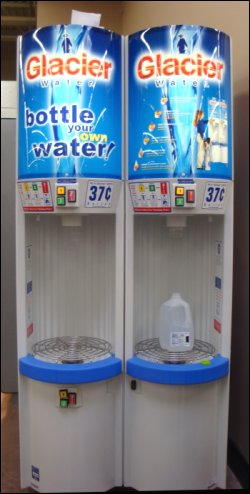Water vending machines let you “bottle your own water” and often buy it much less expensively than buying it pre-bottled, especially at some chain truck stops.
 We all need drinking water to live.
We all need drinking water to live.
Furthermore, certain sources of water can be very expensive.
On this page, we will expose some of the exorbitant prices that get charged for water.
Fill or Refill Your Own Water Jugs
 Many Wal-Mart Supercenters (and possibly other grocery stores) have water machines by which customers can fill or refill one-gallon water jugs for (as of early 2010) $0.37 each.
Many Wal-Mart Supercenters (and possibly other grocery stores) have water machines by which customers can fill or refill one-gallon water jugs for (as of early 2010) $0.37 each.
The company responsible for maintaining the machines shown here is Glacier.
We have also seen machines in Supercenters with the brand name Culligan.
The types of water filtration or treatment may vary between water vending machines.
These particular machines are capable of refilling both one- and five-gallon bottles (hence the extra height).
Empty one- and five-gallon containers may also be on display next to the water vending machines.
Compare this cost with full gallon jugs of water for sale at Wal-Mart Supercenters on the beverage aisle.
Depending on the filtration method and brand as of late August 2010, you can pay anywhere from $0.78 per gallon (store brand of “drinking water”) to a little over $1.00 per gallon (name brand).
We have found that the same size water jugs at truck stops are more expensive than even the higher end gallon water jugs at Walmart, which we’ll describe next…
Truck Stop Water for Sale
 Shown here is a display of one-gallon containers of bottled water for sale at a truck stop.
Shown here is a display of one-gallon containers of bottled water for sale at a truck stop.
You may find them either refrigerated, as shown here, or not refrigerated.
Notice the price: 2/$3 (or $1.50 each).
Ouch!
We didn’t think that gallon water sold in a truckstop could get any more expensive.
But as we were writing this page, Vicki found the display shown here in a small truckstop in North Carolina.
 Notice two things:
Notice two things:
First, this is “natural spring water.”
Second, the cost is $1.69 (which Vicki enlarged in the inset).
Somebody evidently removed one (bought it?) because there is one gallon missing from rack.
The Most Expensive Water We Found, Gallon-for-Gallon
 This is the most expensive way to buy bottled water: in individual bottles.
This is the most expensive way to buy bottled water: in individual bottles.
Some manufacturers attempt to “enhance” water by adding
– flavors,
– sweeteners (natural or artificial),
– coloring and
– perhaps other ingredients.
Let’s take a close-up look at one…
Enhanced Water, Individual Bottles
 Shown here is a 20-ounce bottle of VitaminWater — from the refrigerated case pictured above — on sale at a truck stop for $1.50.
Shown here is a 20-ounce bottle of VitaminWater — from the refrigerated case pictured above — on sale at a truck stop for $1.50.
Let’s do the math and calculate the per-gallon cost of this product:
- 1 gallon = 128 ounces
- 20 ounces/(128 ounces/gallon) = 0.15625 gallon
- $1.50 (for the 20 ounce bottle) / 0.15625 gallon = $9.60/gallon
Double ouch!
Based on cost alone, we think you would be better off drinking plain water.
(Also it is best to get your “vitamins” from good, nutritious, wholesome food.)
Also, we urge you not to fall for the old “It’s just $1.50” tack.
We’ll show below how the money can really add up fast.
Could you be putting your money toward something you would enjoy more and that will last longer?
(Check out our goal setting page.)
Water from Home
If you can get your water “for free” at home, great!
But many professional drivers either don’t have a home or don’t get through home turf often enough to get enough water to last through their entire tours on the road.
That’s where water vending machines come in handy.
Differences in Water Vending Machines
 We have seen two different styles of water vending machines at Wal-Mart locations:
We have seen two different styles of water vending machines at Wal-Mart locations:
– button-delivery and
– handle-delivery.
The one pictured here has button-delivery.
Button 1 (yellow) is supposed to lower a clear plastic cylinder over the mouth of the jug.
(Not all of the machines lower the cylinder.)
Button 2 (green) starts the water vending process.
Button 3 (red) stops the water vending process.
Of course, the opening of the water jug must be directly under the water flow.
Unfortunately, the force of the water coming from some button-delivery water vending machines tends to be so hard that customers cannot get a “full” gallon without manipulating the buttons in a go-stop, go-stop manner.
Water machines with handle-delivery let users control the force of the water coming out.
Your Potential Savings
Let’s do a little more math to determine your potential savings by using a water vending machine to get refills instead of buying new bottles either at a grocery store or a truck stop.
(We’ll use the more common per-gallon truckstop price of $1.50 in our calculations.)
The rule of thumb is that a person is supposed to drink eight 8-ounce glasses of water a day (64 ounces or 1/2 gallon total).
We know that we personally don’t drink anywhere near that amount of water on the road because if we did, we would constantly be stopping to go to the bathroom.
However, for the sake of the calculation, let’s use that figure and various lengths of tour.
Note: We did not include the cost of a new, empty water jug for water refills. We know from experience that some plastic water bottles are much flimsier than others (which is why we reused much sturdier and thoroughly cleaned apple juice jugs).
In our table, the yellow row represents the per-gallon price. All of the other calculations are based on that.

How is Water Used?
 The professional truck driver shown here is dispensing water from a 5-gallon water container that is balanced near or on the catwalk behind his tractor.
The professional truck driver shown here is dispensing water from a 5-gallon water container that is balanced near or on the catwalk behind his tractor.
He was cleaning out his coffee cup.
When you figure how much water you’ll need on the road, you will want to make sure to take into account all of the ways you plan to use water, such as for making hot beverages, cooking and washing dishes.
You may or may not get a better per-gallon price if you buy multiple gallons (such as in a 5-gallon container) at a time.
Since one gallon of water weighs about 8.35 pounds, the weight of a 5 gallon container of water is almost 42 pounds.
Be careful lifting that much weight if you’re not used to it.
We personally consider that one-gallon jugs of water are easier to lift, move and store in the truck.
![]() Money saving tip: Besides using water vending machines to refill water jugs, Vicki makes it a practice to refill the ones we use at the water fountains at Mike’s trucking company’s terminals as often as we come through.
Money saving tip: Besides using water vending machines to refill water jugs, Vicki makes it a practice to refill the ones we use at the water fountains at Mike’s trucking company’s terminals as often as we come through.
There can be differences in water taste depending on where you get it.
Obtain the kind that has been run through the filtration or treatment method of your choice.
The cost of filtering and treating water (such as by distillation or reverse osmosis) can affect the cost of the product.
Make sure that you don’t get short-changed on the amount of water you get from water vending machines.
Just because the water delivery has stopped does not mean you must settle for less than a gallon upon checkout.
To help avoid spills and leaks, consider getting sturdier bottles.
Some folks discourage the use of bottles that have held other products for water refill use.
If you decide to go this route, you will want to be careful to make sure the bottles are clean before you refill them with water.
If you are inclined to buy refill water, make sure that the store you want to park at allows truck parking.
Some Wal-Mart locations are just fine but others are not.
You don’t want to risk getting a ticket or having your rig towed while you are inside.
Also, you can save yourself the fuss and bother of stopping at a Wal-Mart to get refill water when they don’t have water vending machines this way:
– go to www.Wal-Mart.com (or use their app);
– look for store locations;
– look for a store along your route; and
– call ahead of time to ask if they have at least one refill machine in the store.
We were disappointed to learn that the Wal-Mart Supercenter in Albany, GA, did not have water refill machines as of late August 2010.
Another potential way to get water is to get a block or bag of ice for a good cost — such as at an ice vending machine — and let it melt.
We know that ice vending machines such as Ice House America are becoming very popular and are cropping up in a variety of places.
Many of them sell either a 16-pound bag of ice or 20-pound bulk ice (no bag) for around $1.50-$2.00.
If you consider that some truck stops sell a 10-pound bag of ice for $1.99, then this ice is a bargain.
A 16-pound bag of ice can melt into not quite two gallons of water.
Return from Water Vending Machines: Bottle Your Own Water Less Expensively to our Health and Wellness page or our Truck Drivers Money Saving Tips home page.














